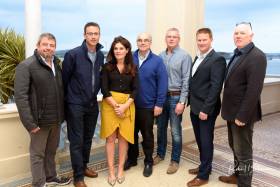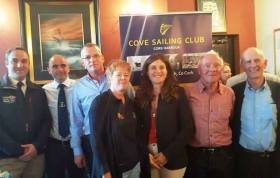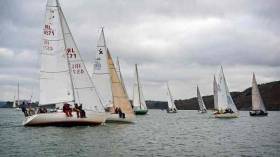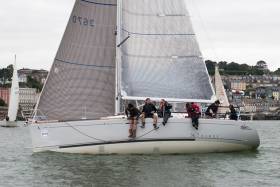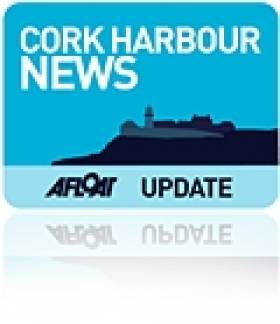Displaying items by tag: Cove Sailing Club
Cove Sailing Club launched an exciting centenary programme at Cork Harbour's Sirius centre in Cobh, the former clubhouse of the Royal Cork Yacht Club on Friday, May 17 writes Bob Bateman.
In order to mark the special occasion, CSC Commodore Kieran Dorgan published a 100-year anniversary booklet commemorating the club's important history from 1919 to 2019.
 CSC Commodore Kieran Dorgan launches the centenary season Photo: Bob Bateman
CSC Commodore Kieran Dorgan launches the centenary season Photo: Bob Bateman
The well attended launch night for the 2019 season – that included the display of vintage club trophies – got an extra boost with the news that Cork County Council had approved Cove Sailing Club plans to construct a new 25 berth marina located at Whitepoint, Cobh as Afloat previously reported here.
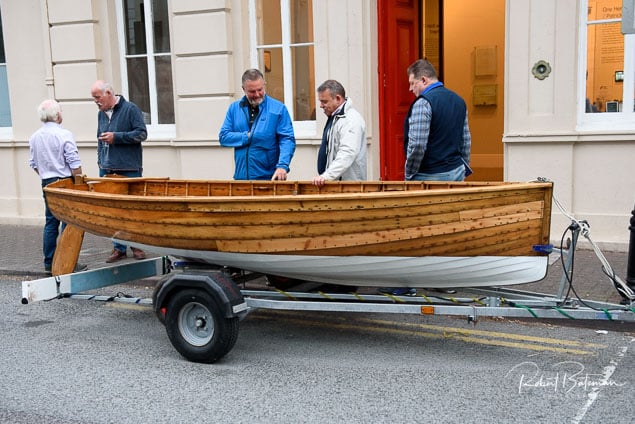 A vintage 'T' Class One Design dinghy (built 1947) on display outside the Sirius Centre for the Cove Sailing Club centenary launch Photo: Bob Bateman
A vintage 'T' Class One Design dinghy (built 1947) on display outside the Sirius Centre for the Cove Sailing Club centenary launch Photo: Bob Bateman
In cruiser racing news from Cobh, Johanna Murphy, the Commodore of SCORA, who attended the CSC function, told Afloat she is expecting a sizeable south coast fleet of 25 boats to race from Great Island Sailing Club in Cobh to Dunmore East on June 1st, the first time the Cork fleet has sailed east to Waterford in a number of years.
The CSC programme was quickly underway with Saturday's race to Ballincurra as Afloat reports here
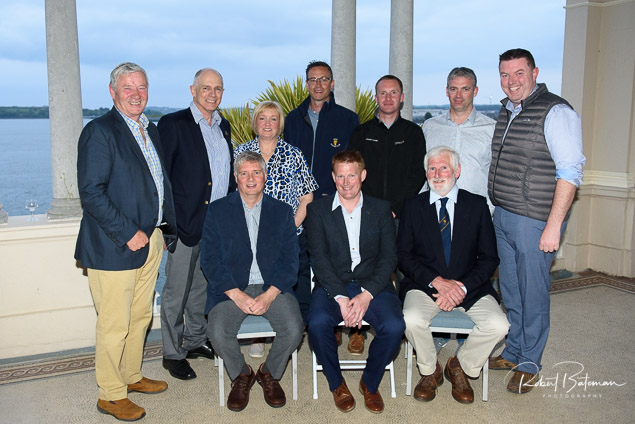 The Cove Sailing Club Committee at the Sirius Centre
The Cove Sailing Club Committee at the Sirius Centre

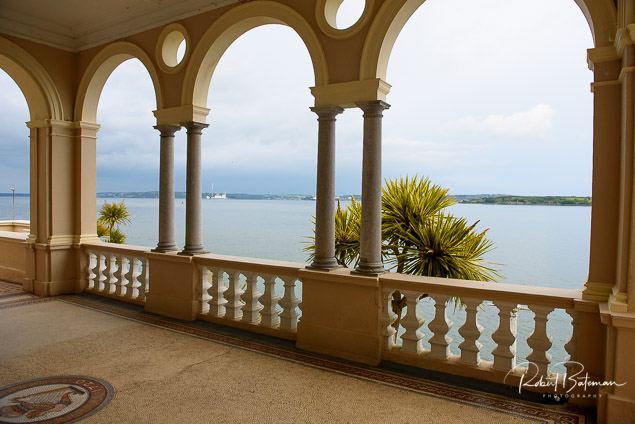

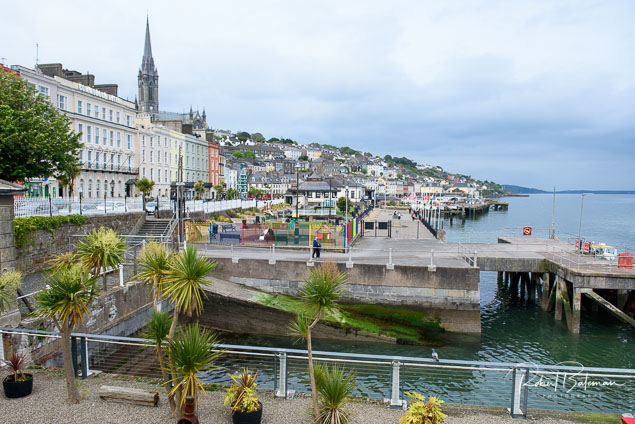

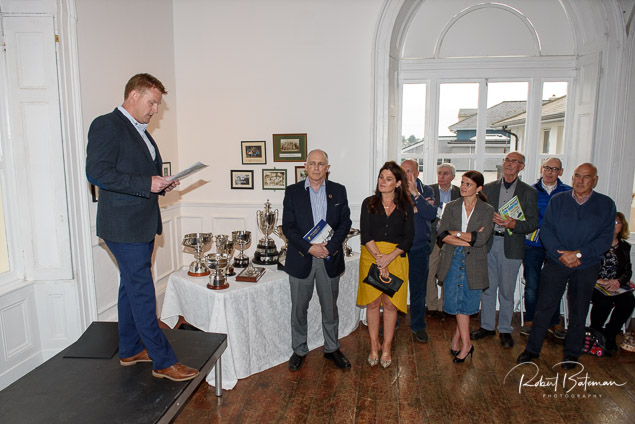



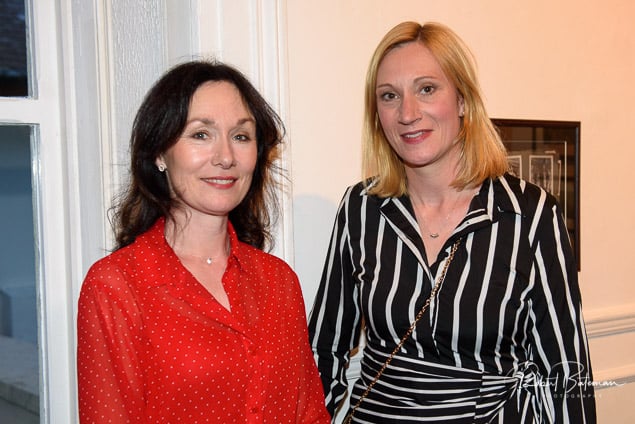

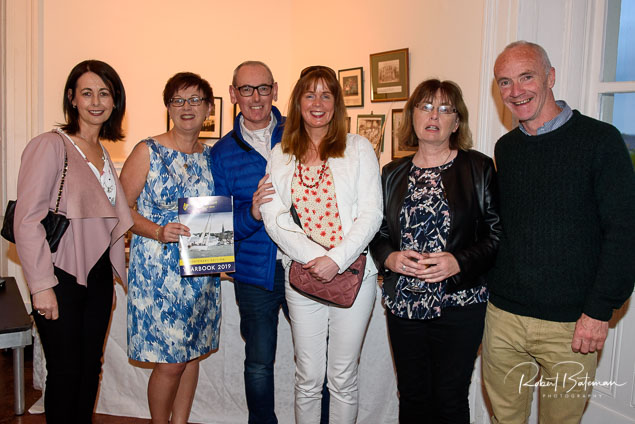
Cove Sailing Club has announced that Cork County Council gave approval on Monday (13 May) to its plans for a new 25-berth marina located at Whitepoint.
Earlier this year saw the display of new plans for the marina, scaled down from a larger scheme that faltered in the planning stages some years ago.
It was reported in the East Cork Journal in March that the new marina plan — touted as a major boost to marine tourism in the Cork Harbour town — would be divided between visitor moorings and club spaces, with a 40m pontoon for ferry sailings to Spike Island.
The club hailed its now green-lit joint venture with the council as “fantastic news for the people of Cobh and the Cork Harbour area” and announced it would be holding meetings in the coming weeks for those interested in a berth or to discuss the project in greater detail.
Cove Sailing Club is also celebrating its centenary this year, and will launch a special yearbook to mark the occasion this Friday evening 17 May from 8pm at the Sirius Arts Centre in Cobh.
New Cobh Marina Plans Set For Public Display
Cobh may finally get a new marina in what’s being touted as a major boost to marine tourism in the Cork Harbour town, as plans are prepared for public display.
The East Cork Journal has details on the new €450,000 development — scaled down from a larger plan that faltered a number of years ago — which would see 25 berths divided between visitor moorings and club spaces, and a 40-metre pontoon that would serve as a ferry port for access to Spike Island.
Future expansion is also envisaged for the new scheme, a joint venture between Cork County Council and Cove Sailing Club — which last month celebrated its 100th anniversary.
The Cork Harbour institution has since been joined in the area by the new Great Island Sailing Club, established after Cove’s previous marina plans failed to progress and prompted concerns over its pressures on sailing activities.
Cove Sailing Club Celebrates 100 Year Anniversary
Cove Sailing Club in Cork Harbour this year celebrates its 100th year anniversary and plans are in place to celebrate its history and further lay new roots to carry it on and grow for another 100 years writes Commodore Kieran Dorgan.
From the early days of the William Fife designed “Cork Harbour One Designs” Cove Sailing Club has a strong affiliation with boat building and the town itself. Today this is ever present with the large
number of “Rankin” dinghy boats that sail up and down the harbour front linking the clubs past and its future.
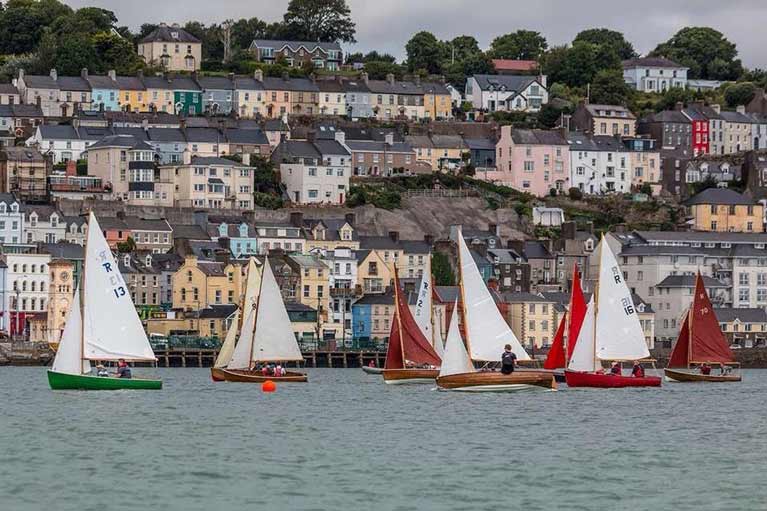 Rankin dinghy sailing off Cobh Photo: Mary Kidney
Rankin dinghy sailing off Cobh Photo: Mary Kidney
2018 was a defining year as the club worked diligently to build on its history and set about securing a solid foundation to continue and provide a platform for the people of Cobh and the surrounding areas
to enjoy sailing and all the fun and excitement it offers.
"2018 was a defining year as the club worked diligently to build on its history"
A detailed plan of all the events marking this historic year will be published in the coming weeks and we invite all past and present members to help share their memories, stories and pictures with the
Club.
The club is committed and focused in its pursuit to provide a marina facility that will be all-encompassing for the many varied sporting organizations to enjoy through Cobh, East Cork and
Harbour area; continuing the hard work and dedication of previous committees to deliver this most sought after piece of community infrastructure.
 The Cobh to Blackrock yacht race Photo: Bob Bateman
The Cobh to Blackrock yacht race Photo: Bob Bateman
The committee is working hard to produce our 100-year anniversary booklet and feel this will be a very special collaboration on the club's history.
The 2019 Sailing season promises to be a bumper year on the water with the return of the family-friendly, Social, Friday night racing in July and August for the cruiser classes providing a stepping
stone for new and novice members to try sailing and racing. Along with the highly successful “Cork Harbour Combined Clubs League” with our neighbouring clubs, 2019 will be a busy summer for all.
We will endeavour to provide a safe fun space for our junior members to learn and develop their sailing skills through weekly summer racing and professionally accredited sailing courses.
The club is really looking forward to hosting some of the harbour’s most special races including the fabulous “Brooklands Cup” and “Ballinacurra Cup” for dinghies made famous by the visiting boats
from around the harbour including the highly competitive but very social National 18 Class.
Our annual “Cove at Home” invites cruiser and dinghy classes from all over the harbour to race in front of our iconic home town under the watchful eye of St. Colman’s Cathedral which also celebrates its
100 year anniversary of consecration in 1919.
The “Cobh Peoples Regatta” in August will be a celebration of sail with boats vying to win the Harbour’s most valuable silverware. The regatta will also host a very unique race for the “Rankin
Trophy”; this is an annual gathering of these very special boats and embodies the spirit of “Cove Sailing Club”.
The culmination of the 100-year celebration is the Legendary “Cobh to Blackrock” race and plans are afoot to have 100 boats compete in this annual harbour classic.
Our full range of membership for the 2019 season is now open.
Further information about membership and the 100-year celebrations will be provided on our club website www.covesailingclub.ie over the coming weeks.
Cork Harbour will have a new name in sailing this season - the Great Island Sailing Club, formed to ensure the continuance of sailing at Cobh, following difficulties which arose in Cove Sailing Club as it attempted to build a marina at Whitepoint.
The development is on an amicable basis between the two clubs, according to both.
“The aim is to ensure that sailing continues and develops in Cobh and the new club is open for membership and registration,” said Johanna Murphy, Commodore of the new club where the Sailing Secretary is Pat Coakley
Kieran Dorgan, Commodore at Cove Sailing Club, said that club is continuing to pursue the completion of the marina. “The Committee are working to resolve the situation and wish to support sailing/boating activities in any way it can. We are fully committed to getting the club through the current situation, the marina completed and to continue with sailing/boating in the coming years. The centenary anniversary of the club is due to happen next year and our aim is to have the marina in place for the people of Cobh.”
“Everyone is working together to ensure that sailing continues and develops. That is what we all want for the harbour and for Cobh. Concentrating on that is what the Great Island Sailing Club will be doing,” said the Great Island SC Commodore, Johanna Murphy. “Things are progressing after the difficulties which arose, which it was necessary to resolve to ensure the continuance of sailing activities.”
Meetings were held over the past few months to resolve the situation, when members expressed concern that sailing activities were being affected by the demands of developing the marina.
The outcome is a decision to form the new club, to which cruiser and dinghy sailing is moving, while Cove Sailing Club continues in existence, with its focus on the marina. Cove SC is making its resources of support boats and dinghies available to the new club.
Developing a marina is a challenging and financially demanding business. The plans of Cove SC were hit when an expected and, it is understood, promised financial support grant from the public body, SECAD, did not materialise. The Port of Cork, which encountered public opposition to its own plans for major development at Ringaskiddy amidst concerns, particularly at Monkstown, for its possible impact on sailing, expressed objection concerns about the Cove SC marina plans, apparently because of its own expansion of cruise line berth facilities at Cobh.
A formal launch is planned in May, with a programme for both cruiser and dinghy sailing and the continuance of junior training.
The new club will be involved in joint sailing with the Royal Cork YC and Monkstown Bay SC, the Naval sailing Squadron and Eddie English’s Sail Cork, according to Johanna Murphy.
• Podcast below
Cove Sailing Club Announces Link-up With Monkstown Bay to Boost Cruiser Racing in Cork Harbour
Cove Sailing Club launched its programme for the season with confirmation of joint cruiser racing to be sailed with neighbouring Monkstown Bay SC in an attempt by both clubs to boost cruiser participation in Cork Harbour writes Tom MacSweeney.
Cove SC Commodore Joanna Radley and Monkstown Bay’s Cruiser Class Captain Henry Jefferies said that the development had been discussed for some time and that both clubs would continue to have their own dedicated events, while also combining racing which would be held alternately at Cobh and Monkstown. Both clubs had experienced declining fleet numbers over recent seasons and this was a determined attempt to reverse the trend.
Royal Cork Yacht Club’s Rear Admiral for Keelboats, Kieran O’Connell, who was present welcomed the development and said that the RCYC would look forward to the possibility of joining in next season when all three clubs could strengthen cruiser racing.
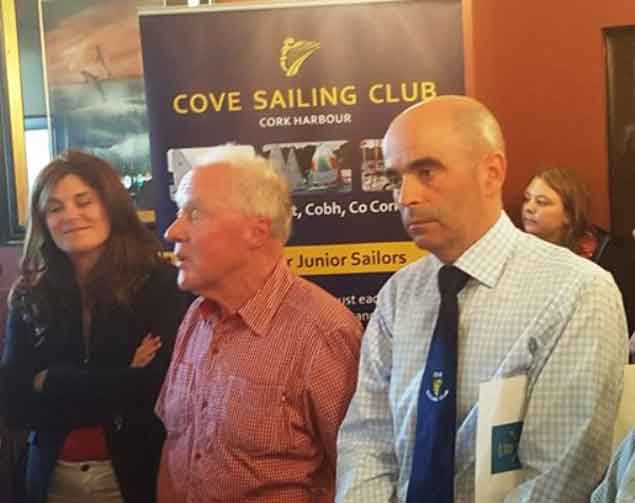 Cove Sailing Club Commodore Joanna Radley, Monkstown Bay Cruiser Class Capt Henry Jefferies and Cove Sailing Secretary Pat Coakley at the Announcement of the Joint Racing programme
Cove Sailing Club Commodore Joanna Radley, Monkstown Bay Cruiser Class Capt Henry Jefferies and Cove Sailing Secretary Pat Coakley at the Announcement of the Joint Racing programme
“This is a wonderful harbour, with great opportunities for sailing, of which every opportunity should be taken,” is the approach being taken by the clubs. The joint Cove/MBSC events will concentrate on whitesail, which is the focus of Monkstown Bay SC cruisers. Cove includes spinnakers in its racing events.
The agreed approach, as previously reported by Afloat.ie will start with both clubs joining forces for the first time on Sunday May 21, starting together on the Cove SC line and again the following Saturday, May 27 On Saturday, June 3, the June Bank Holiday Weekend both clubs will race in Monkstown. The clubs will gather together again in Cobh on four Fridays in June – 9, 16, 23 and 30. A race to Kinsale, which will also be a ‘feeder’ for the Sovereign’s Cup there, is planned on Saturday, June 17. For boats not taking part in the Cup series, there will be a race back to Cork Harbour the following day.
 Kieran O'Connell RCYC Rear Admiral Keelboats – looks forward to the possibility of joining in next season when all three Cork Harbour clubs could strengthen cruiser racing
Kieran O'Connell RCYC Rear Admiral Keelboats – looks forward to the possibility of joining in next season when all three Cork Harbour clubs could strengthen cruiser racing
In July Monkstown will hold its ‘At Home Regatta’ on Saturday, July 8, which SCORA, the South Coast Offshore Racing Association, is expected to support and on Saturdays, July 15, 22, 29, Cove will join MBSC in racing at Monkstown. On Sunday, July 23 racing will be in Cove. On Saturday, September 2, the Ballinacurra Race will start from Cove and finish in East Ferry. Saturday, September 9, is the date scheduled for the annual Cobh-to-Blackrock Race and there are joint MBSC and Cove SC events planned on Saturdays September 16, 23 and 30.
“Hopefully, this inter-club initiative will boost cruiser racing in Cork Harbour,” officers of both clubs said.
At the launch in the Quays bar and restaurant on the Cobh waterfront, Cove Sailing Secretary, Pat Coakley, announced an extensive sailing programme for both the club’s dinghy and cruiser fleets. Saturday sailing will include a dedicated training schedule, outlined by Michelle Gray Mooney.
 Maurice Kidney outlining the Rankin Dinghy Revival at the Cove Sailing Club Launch
Maurice Kidney outlining the Rankin Dinghy Revival at the Cove Sailing Club Launch
Maurice Kidney detailed the revival of the Rankins, the historic dinghy associated with Cove SC. On Saturday, May 20, the Rankins are planning a gathering in Cobh and Crosshaven for Ida Hadley, the sister of boat builders Eric and Dave Rankin, who built these wonderful Cork harbour dinghies from the late 50s to the 80s.
Cork Harbour Sailing Clubs Join Forces to Develop Cruiser Racing
Monkstown Bay and Cove Sailing Clubs have agreed a joint cruiser racing programme for this season which will set a new course in Cork harbour sailing, writes Afloat's Tom MacSweeney in the Evening Echo.
The neighbouring clubs have been in discussion for some time with the aim of engaging in joint racing. Like clubs around the country, it has been proving difficult to maintain cruiser racing, so getting together for inter-club racing is a way forward in strengthening interest in the sport.
Monkstown Bay SC cruisers concentrate on white sail racing while Cove has both white sail and spinnaker classes.
Both have agreed a series of inter-club white sail events, when cruisers from both will race together. They will also run their own club sailing programmes, so this could be the ‘best of both worlds’ for the sailors. It is a positive development, one to be welcomed in bringing clubs in Cork Harbour together.
While there may be some adjustments to the schedule as the season progresses, which can invariably happen with the best-laid plans, the agreed approach involves both clubs joining forces on Sunday May 21 and Saturday, May 27, starting together on the Cove SC line. Monkstown will, in the same month run its own weekly Thursday night league. Cove will launch its sailing programme with a formal announcement of the season’s plans on May 5.
On Saturday, June 3, the June Bank Holiday Weekend both clubs will race in Monkstown which will also be the Sea Hennessy Trophy for Monkstown boats, to honour that village’s much-revered sailor, the late Charlie Hennessy. The clubs will gather together again in Cobh on four Fridays in June – 9, 16, 23 and 30. A race to Kinsale, which will also be a ‘feeder’ for the Sovereign’s Cup there, is planned on Saturday, June 17. For boats not racing in the Cup series, this will be an overnight occasion, with a race back to Cork Harbour the following day.
In July Monkstown will hold its ‘At Home Regatta’ on Saturday, July 8, which SCORA, the South Coast Offshore Racing Association, is expected to support and on Saturdays, July 15, 22, 29, Cove will join MBSC in racing at Monkstown. On Sunday, July 23 racing will be in Cove.
August is generally the month when boats head West for holiday cruising, so no joint racing is planned, but they will gather again in September. On Saturday, September 2, the Ballinacurra Race will start from Cove and finish in East Ferry. Saturday, September 9, is the date scheduled for the annual Cobh-to-Blackrock Race and there are joint MBSC and Cove SC events planned on Saturdays September 16, 23 and 30.
Hopefully, this inter-club initiative will boost cruiser racing in Cork Harbour.
Cork Harbour Cove to Blackrock Race (PHOTO GALLERY HERE)
Cove Sailing Club's own Beneteau First 36.7 Altair was the class one winner of yesterday's annual Cobh to Blackrock race writes Bob Bateman. The Cork Harbour fixture that was postponed due to bad weather a fortnight week ago set sail in light westerly winds yesterday with a good turnout of all sorts of cruisers and dinghies that included some local Rankin dinghy entries.
The course was upriver from the start line at Cobh to the finish line at Blackrock Castle.
Cove Sailing Club Commodore Aidan Mc Aleavey, with support from the Naval Squadron's Soubrette from Haulbowline acting as comittee boat, sent the fleet off with a flooding tide and a beat up to Whitepoint then a reach onwards to Marino Point.
The dinghy fleet started first then the white sail division followed by traditional craft with racing classes 1,2,3 last to start.
Second in class one was Ria Lyden's X332 Ellida with Paul Tingle's X34 Alpaca from Royal Cork third.
George Radley's Half tonner Cortegada was the class two winner. The race is part of CSC September League. Full results are here
Cobh to Blackrock Race 2016 Postponed Due to Forecast
Due to this weekend's unfavourable weather forecast for Cork Harbour, Cove Sailing Club has postponed its Cobh to Blackrock Race until Saturday the 17th of September.
Cove Sailing Club Expect Over 100 Yachts for Annual Cobh to Blackrock Race
#cove – Starting at 13:00hrs off Cobh Promenade on Saturday, Cove Sailing Club stages its annual Cobh to Blackrock Race season highlight in Cork Harbour. The Port of Cork and Union Chandlery have once again agreed to sponsor this year's racing that attracted over 100 boats in 2013.
The course is to continue along its traditional route passing Ringaskiddy, Monkstown, Passage, across Lough Mahon and along to the finish at Blackrock Castle.
All boats are then invited to continue up to the City Quays where complimentary overnight berthing will be provided by the Port of Cork at the Cork City Marina.
This year Cove Sailing Club are also very pleased to be able to invite competitors and their guests to the prize-giving at The Sextant which is just opposite the City Quays marina. A barbecue and home-made pizzas will be available at preferential prices for crews together with the Sextant's huge range of top quality beer and wine.


























